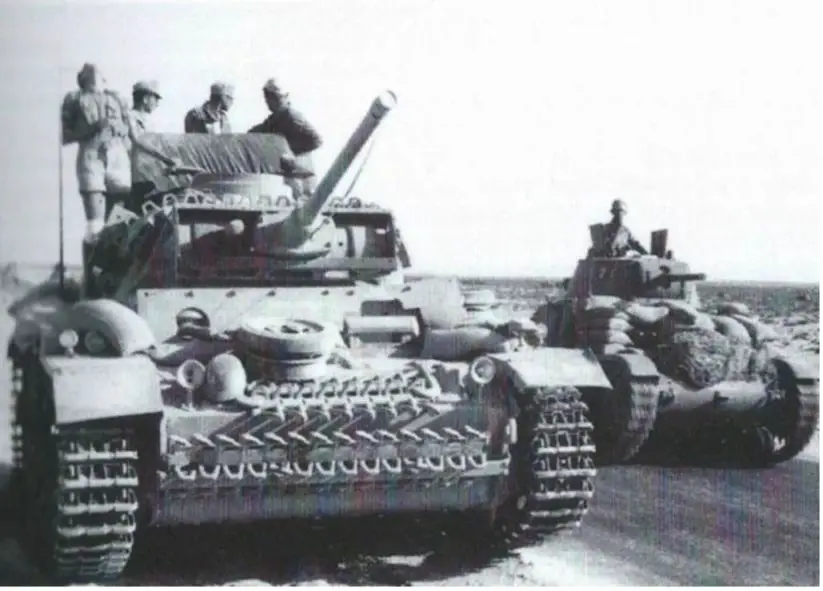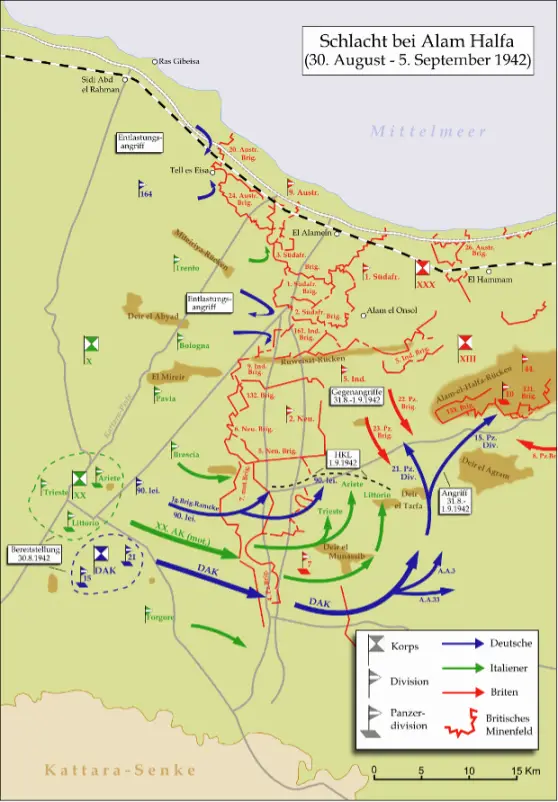
The final offensive push of the German and Italian divisions in North Africa, stopped after just 3 days of fighting due to bad planning, lack of surprise and the material superiority of the 8th Army.
Context
The victory at Gazala and the subsequent fall of Tobruk in Axis hands opened up Rommel’s race to Suez. Believing the 8th Army was torn apart, and confident that the supplies captured in Tobruk would have sustained his chase, Rommel launched his weakened army across hundreds of kilometers, increasingly far from the axis supply bases and ports. The race halted before the El Alamein, a narrow passage between the sea and the Quattara depression. During July, the remaining Axis and Commonwealth forces clashed hard in the so-called first battle of El Alamein. No side prevailed and both opponents got severely weakened by the prolonged fight. A long operational pause followed as the two enemy armies started to build up for the next punch.
The Allied side
The British 8th Army set on well-prepared defensive positions running from the sea down to the south and then to the interior, namely over the rocky ridges of Ruweisat and Alam Alfa. By mid-August, General Auchinleck was no more in command, and the 8th Army was now led by a somewhat unknown General called Bernard Law Montgomery. Large reinforcements (in particular 300 Sherman tanks) were on the way so the 8th Army was set on a defensive posture, ready to repeal any Axis offensive, until late September or October, when the time for a new offensive would have come. Montgomery implemented the defensive plan prepared by Auchnleck, with the only change of deploying one more infantry brigade with anti-tank guns on the positions of Alam Alfa.
The Axis side
After the high losses suffered in the long race towards Egypt, by the end of August, the Axis army had almost replenished its ranks and Rommel felt ready for his next offensive move. To present you with some numbers, by this time the Axis army counted 244 Italian M tanks (M13/40 and M14/41), 38 Italian L tanks (L6 and L3), 32 AB41 armored cars, 36 SPGs 75/18, 203 German Panzers (Mostly Panzer III and IV), 47 armored cars and 11 tank destroyers.
Rommel knew that the allied reinforcements were on the way so he had limited time to crush the 8th army and reach the valley of the Nile. He bet once again on the surprise element, ignoring the fact that the British command knew about his plans thanks to ULTRA, and specifically knew about his envisioned southern flanking movement, similar to the one performed at Gazala.
The Battle
The movement of Italian and German armored and motorized columns began in the late hours of the 30th of August. The units involved were the Italian divisions Trieste, Littorio and Ariete, the German 21st and 15th Panzer divisions and the 90th Light division. The idea was to cross the frontline with the cover of darkness and reach the established positions south of Alam Alfa by around 3:00 AM on the 31st of August. In theory, this would have reduced the interference of the Desert Air Force and confused the British about the Axis movements.
However, the plan did not unfold very well from the beginning. German and Italian units encountered very soon a large, unmarked minefield called “February” which inflicted severe losses and delayed the advance. When “February” was surpassed, it was the time to cross a second (known) minefield called “January”. These operations caused crucial delays and several German units got lost in the night, taking the wrong routes. In addition, the Desert Air Force appeared on the scene illuminating the area with flares and allowing for some artillery bombardment.

Figure 1 Rommel’s plan (from Montanari’s book, see sources)

Rommel’s forces ultimately reached their objectives with some 12 hours delay and in the afternoon (at around 3:00 PM) the 21st panzer division launched an attack northwards, in an area located southwest of Alam Alfa ridge. Here they met the counterattack of the 22nd tank brigade, supported by the artillery deployed over Alam Alfa. The German tanks withdrew and Rommel ordered his units, including the Italian divisions to form a defensive line, expecting an enemy counterattack.
On the second day, the 15th Panzer division attempted to capture the positions of Alam Alfa, but these proved to be too though to crack and the division withdrew with not negligible losses. During the night, aerial bombardments destroyed some forward fuel depots behind the Axis line. These losses, coupled with the delays in the advance, the failed attacks and the sandy ground encountered on the way, were dramatically reducing the fuel reserves of the Axis army, thus compromising the whole operation.
On the third day, facing the Air dominance of the Desert Air Force and with limited fuel reserves, Rommel decided to orderly withdraw his forces. In the morning of the 3rd of September, the Axis divisions began their movement towards the initial positions, constantly hit by the Desert Air Force, which reached its operational “peak” on that day, deploying more than 500 aircraft in 2700 missions, an average of 35 aircraft over the battlefield every hour.
The end of the battle
During the night between the 3rd and 4th of September, the 8th Army launched operation “Beresford”, an attempt to cut out the Axis salient, targeting the conjunction between Italian and German forces (Namely the Folgore and 90th light divisions). The 132nd infantry brigade led the assault and the action evolved into a series of confused fights in the night where the men of the Folgore division inflicted significant losses to the advancing enemy infantry. The push south was then called off in the morning of the 4th and the armored and motorized Axis divisions withdrew behind the minefields. The cautious Montgomery decided to not risk a counterattack against the retreating forces, he preferred to build up for his upcoming big offensive.
The losses after the battle of Alam Alfa (or the second battle of El Alamein in Italian military history) were as follows:
1,750 casualties of the 8th Army plus 68 tanks
1,051 Italian casualties and 11 tanks lost
1,824 German casualties and36 tanks lost
This was the last offensive operation of the Axis forces in North Africa and, after its failure, the Panzerarmee Afrika set on defensive positions waiting for the next punch of the 8th army.
Sources
Montanari, M. (1989). Le operazioni in Africa settentrionale, Volume III: El Alamein (Parte seconda). Roma: Ufficio storico dello stato maggiore dell’esercito.
Santangelo, A. (2020). La battaglia di El Alamein. Il Mulino.